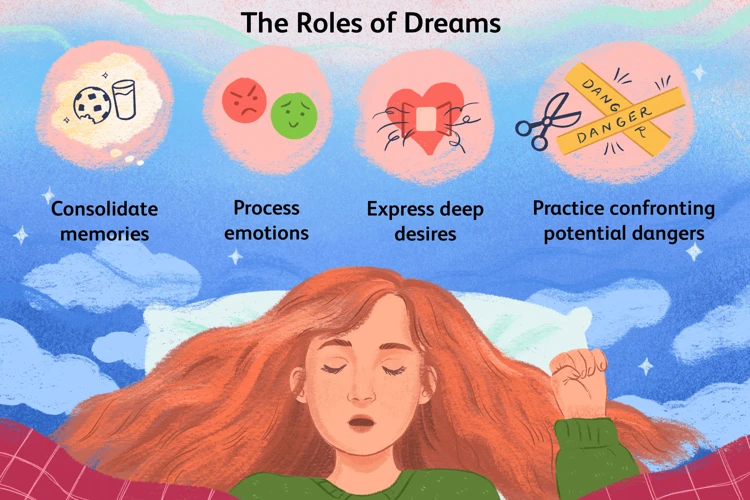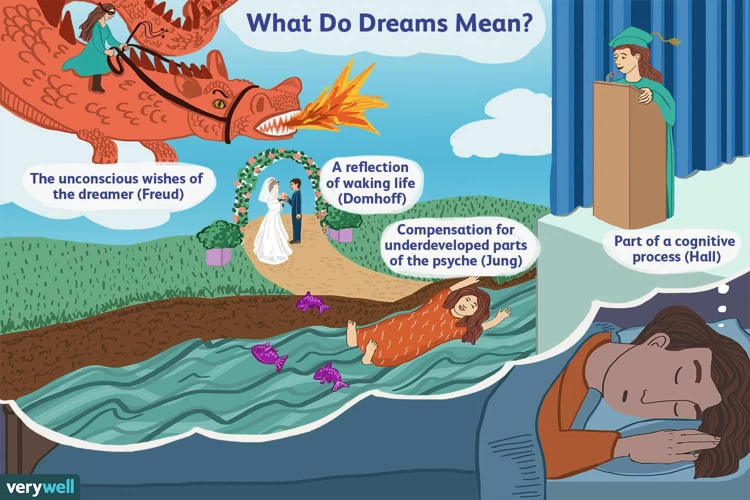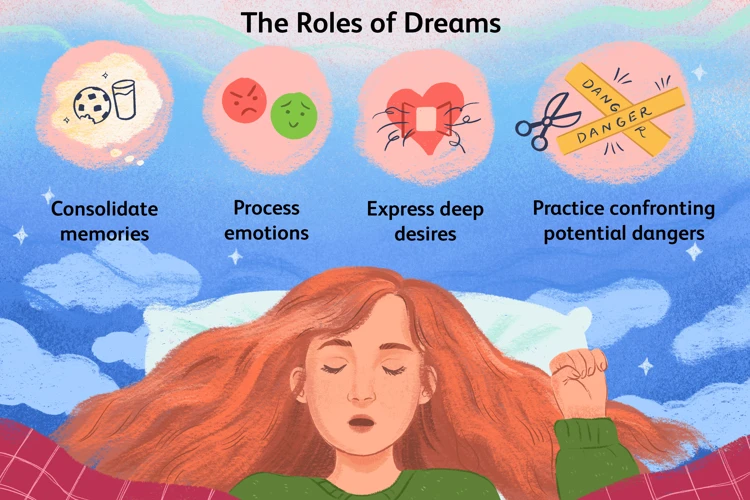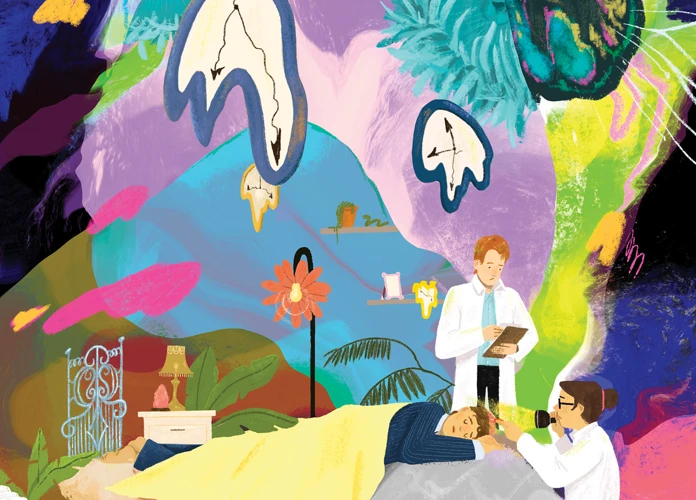Why do we dream? What is the connection between our dreams and our mental health? These questions have fascinated humans for centuries. Dreams have been a subject of intrigue, curiosity, and interpretation. They can be vivid and bizarre, taking us on journeys through surreal landscapes or bringing forth our deepest fears and desires. But beyond their enigmatic nature, dreams serve a purpose in our lives. They offer a glimpse into our unconscious mind, provide emotional regulation, and reflect our mental state. In this article, we will explore the psychological significance of dreaming, the connection between dreams and mental health, various dream analysis techniques, the role of dreams in trauma processing, and practical tips to enhance dream recall and explore the realm of lucid dreaming. So, fasten your seatbelts, and get ready to unlock the intriguing world of dreams!
The Purpose of Dreams

The purpose of dreams has long perplexed scientists and psychologists alike. While there is no definitive answer, several theories suggest that dreams serve important functions in our lives. One such theory is that dreams allow for unconscious processing, helping our minds sort through the vast amount of information we encounter during the day. This processing may involve consolidating memories, problem-solving, and creative thinking. Dreams also play a role in emotional regulation, allowing us to process and express emotions that may be difficult to confront in our waking life. Some researchers believe that dreams provide a safe space to explore and resolve emotional conflicts. Additionally, dreams can reflect our mental state, offering insights into our thoughts and feelings. By analyzing dream symbols and themes, we can gain a deeper understanding of our unconscious mind and its influences on our mental health (source). The purpose of dreams is a complex and fascinating topic that continues to be explored by experts in the field.
1. Unconscious Processing
Unconscious processing is a significant aspect of dreaming that plays a crucial role in our cognitive functioning. During sleep, our brains continue to process information from our waking life, even when we are not consciously aware of it. This process involves the consolidation and integration of memories, problem-solving, and creative thinking. Dreams provide a platform for this unconscious processing to occur.
One theory suggests that dreams help us organize and make sense of the events and experiences we encounter throughout the day. As we dream, our brains sift through these memories, evaluating their importance and significance. This process assists in consolidating and storing important information in our long-term memory, while discarding irrelevant or trivial details.
Dreams also serve as a playground for problem-solving and creative thinking. Have you ever woken up with a brilliant idea or a new perspective on a challenging problem? This phenomenon is a result of the unconscious processing that takes place during dreaming. Our minds can work through complex issues while we sleep, tapping into our innate problem-solving abilities and presenting us with novel solutions.
Dreams offer a unique opportunity to tap into our creative potential. Artists, writers, and musicians often draw inspiration from their dreams, as the uninhibited nature of dreaming allows for the exploration of new ideas, abstract concepts, and unconventional perspectives.
By delving into dream analysis and interpreting the symbols and scenarios that arise during sleep, we can gain insights into our thought patterns, desires, and hidden emotions. Unconscious processing through dreams allows us to navigate and make meaning of our waking experiences, contributing to our overall mental well-being and personal growth. So, embrace the mysterious realm of dreams and unlock the power of your unconscious mind.
For a comprehensive guide on dream symbols and their interpretations, refer to our article on Analyzing Dream Symbols. Additionally, if you’re interested in exploring the hidden desires that may manifest in your dreams, check out our insights on Interpreting Sexual and Erotic Dreams.
2. Emotional Regulation
Emotional regulation is a significant function of dreams. During sleep, our minds have the opportunity to process and integrate emotional experiences from the day. Dreams provide an outlet for expressing and releasing pent-up emotions, which can help regulate our emotional well-being. They allow us to explore and confront difficult emotions in a symbolic and metaphorical way, which may be more manageable than addressing them directly in waking life.
One way dreams facilitate emotional regulation is through the process of emotional discharge. When we experience intense emotions throughout the day, such as stress, anxiety, or sadness, these emotions can carry over into our dream world. Dreams provide a safe space where we can fully experience and express these emotions without the same consequences as in our waking life. It’s not uncommon to wake up from a dream feeling a sense of emotional release or catharsis, as if the dream has allowed us to work through and let go of those emotions.
Dreams also offer an opportunity for emotional problem-solving. When faced with challenging situations or conflicts, our dreams can present alternative scenarios and perspectives. They can provide us with insights and creative solutions that may not be immediately apparent in our conscious waking mind. By unraveling the symbolism and underlying messages in our dreams, we can gain valuable emotional guidance and clarity.
Understanding the emotional aspects of our dreams can provide valuable insights into our mental health and emotional well-being. By paying attention to recurring emotional themes, patterns, and symbols in our dreams, we can identify unresolved emotions, trauma, or areas of our life that require attention. Dream journaling and reflection can be helpful tools in exploring and interpreting the emotional content of our dreams. Regularly engaging in activities that promote emotional well-being, such as self-care, therapy, and stress management, can also positively impact our dream experiences and emotional regulation.
Emotional regulation is a vital function of dreams, allowing us to process and navigate our complex emotions in a safe and symbolic realm. By actively engaging with our dreams and recognizing their emotional significance, we can enhance our understanding of ourselves and promote better emotional well-being in our waking life.
The Connection Between Dreams and Mental Health

Understanding the connection between dreams and mental health is a captivating area of study. Dreams have been found to have a profound impact on our psychological well-being. Firstly, dreams can serve as a reflection of our mental state, giving us insights into underlying emotions, fears, and anxieties. For example, a recurring nightmare may point to unresolved trauma or stress in our lives. Secondly, dreams have therapeutic potential. They can be used as a tool in psychotherapy, providing a safe space to explore and process emotions. Through dream analysis and interpretation, individuals can gain a deeper understanding of themselves and work through psychological challenges. Dreams can offer creative solutions to problems or present new perspectives on life issues. Research suggests that individuals who engage with their dreams and integrate them into their waking lives experience enhanced mental health and well-being. The connection between dreams and mental health is intricate and multifaceted, highlighting the power of our dreams to influence our psychological state (source).
1. Dream Reflection of Mental State
Dreams have long been seen as a reflection of our mental state, providing valuable insights into our thoughts, emotions, and overall psychological well-being. When we dream, our unconscious mind takes center stage, freely expressing ideas and emotions that may be suppressed or unnoticed during our waking hours. Dreams can serve as a mirror reflecting our deepest fears, desires, and unresolved conflicts. For example, someone experiencing stress or anxiety may have recurring dreams of being chased, representing their feeling of being pursued or overwhelmed by life’s challenges. Similarly, dreams can reveal underlying issues such as self-doubt, insecurity, or unresolved trauma. By paying attention to the content and symbolism of our dreams, we can gain a better understanding of our mental state and identify areas of personal growth or healing that may be needed. Dream analysis, including techniques such as interpreting symbols and keeping a dream journal, can help unlock the hidden messages that our dreams hold, allowing us to explore and address our mental health in a deeper and more meaningful way. By acknowledging and exploring the reflection of our mental state in our dreams, we can gain valuable insights that can contribute to our overall well-being and personal development.
2. Dreams as a Therapeutic Tool
Dreams have long been recognized for their potential therapeutic value. Through the practice of dream therapy, clinicians and psychologists have found that exploring and analyzing dreams can provide valuable insights into a person’s psyche, emotions, and experiences. As a therapeutic tool, dreams offer a unique window into the unconscious mind, allowing individuals to gain a deeper understanding of themselves and their challenges.
One approach to dream therapy involves encouraging clients to engage in active dream exploration and analysis. This may involve recording dreams in a journal, discussing them in therapy sessions, and examining the symbolism and themes present in the dreams. By delving into the content of dreams, individuals can uncover unconscious thoughts, unresolved conflicts, and emotional patterns that may be impacting their mental well-being. This process can lead to increased self-awareness and provide a foundation for personal growth and healing.
Another aspect of dream therapy involves the use of dreams to process traumatic experiences. When a person experiences a traumatic event, the mind often struggles to integrate the experience into conscious awareness. This can lead to symptoms such as nightmares, flashbacks, and emotional distress. Dream therapy offers a safe and controlled environment to reprocess and resolve these traumatic memories within the context of the dream. Therapists trained in techniques like EMDR (Eye Movement Desensitization and Reprocessing) can guide clients in revisiting and transforming the content of their nightmares, allowing for healing and recovery.
Dreams can be a powerful therapeutic tool. They have the potential to reveal deep insights, provide emotional release, and facilitate personal growth. Whether used in individual therapy sessions or group settings, dream therapy offers a unique approach to understanding and resolving psychological challenges (source). By harnessing the power of dreams, individuals can tap into a valuable resource for self-exploration and healing.
Dream Analysis Techniques

Dream analysis techniques offer a window into the deeper meanings and symbolism behind our dreams. One widely known approach is the Freudian interpretation, which focuses on the role of the unconscious mind and the influence of repressed desires and conflicts. According to Freud, dreams are a pathway to the unconscious, and by analyzing dream symbols and content, we can uncover hidden meanings and gain insight into our psychological state. Another prominent technique is the Jungian approach, developed by Carl Jung. Jung believed that dreams serve as a bridge to the collective unconscious, containing archetypal symbols and themes that connect us to our shared human experiences. By exploring these symbols and their personal significance, individuals can uncover valuable insights about themselves and their journey of self-discovery. A more modern perspective is the cognitive-behavioral approach, which focuses on the thoughts, emotions, and behaviors associated with dreams. This approach examines the meaning and functions of dreams within the context of an individual’s beliefs, experiences, and cognitive processes. By analyzing the patterns and themes in their dreams, individuals can gain a better understanding of their underlying thoughts and attitudes. Dream analysis techniques provide valuable tools for self-reflection, personal growth, and the exploration of the mysterious realm of the unconscious mind.
1. Freudian Interpretation
Freudian interpretation of dreams is based on Sigmund Freud’s psychoanalytic theory. According to Freud, dreams are the “royal road to the unconscious.” He believed that dreams were symbolic representations of unconscious desires, fears, and conflicts. In this approach, dream analysis focuses on uncovering hidden meanings and understanding the symbolic language of dreams.
Freud believed that dreams were a result of repressed thoughts and wishes that were unacceptable to the conscious mind. By analyzing dream symbols and content, Freud aimed to bring these unconscious desires to light. He emphasized the importance of sexual and aggressive instincts in dream symbolism, suggesting that many dreams revolve around these themes.
One key concept in Freudian interpretation is the idea of dream censorship. According to Freud, the mind protects itself from disturbing or unacceptable thoughts by distorting their meaning in dreams. This distortion is known as dream censorship, and it can manifest in various ways, such as through symbols, displacement, or condensation.
Another important aspect of Freudian interpretation is the division of dreams into manifest content and latent content. The manifest content refers to the literal storyline and imagery of the dream, while the latent content represents the hidden meaning behind these elements. Freud believed that by analyzing the latent content, one could gain insight into the unconscious conflicts and desires being expressed in the dream.
Freudian dream interpretation often involves free association, where the dreamer expresses whatever comes to mind when discussing their dream. This allows for the exploration of personal associations and unconscious material that may lie beneath the surface of the dream.
While Freudian interpretation of dreams has received criticism over the years, it remains a significant part of dream analysis. It provides a framework for understanding the symbolic language of dreams and exploring the depths of the unconscious mind. However, it is worth noting that dream analysis has evolved since Freud’s time, and other perspectives, such as Jungian and cognitive-behavioral approaches, offer alternative interpretations and understandings of dreams and their psychological significance.
2. Jungian Approach
The Jungian approach to dream analysis stems from the theories of renowned Swiss psychiatrist Carl Jung. According to Jung, dreams are not just random images but rather a manifestation of the collective unconscious, a deep reservoir of archetypal symbols and experiences shared by all of humanity. Jung believed that dreams convey messages from the unconscious mind, offering insights into our personal growth and individuation process. In the Jungian approach, dreams are seen as symbolic representations of our deeper selves and the unconscious forces at play in our lives. To analyze dreams from a Jungian perspective, one must delve into the symbolism and imagery present in the dream. Archetypes, such as the Wise Old Man, the Shadow, or the Anima/Animus, are common symbols that hold universal meanings. By exploring these symbols and their personal significance, individuals can gain a deeper understanding of their own psyche and uncover hidden aspects of themselves. The Jungian approach to dream analysis emphasizes the integration of the conscious and unconscious aspects of the self, leading to self-awareness, personal growth, and a more holistic understanding of one’s mental and emotional well-being (source).
3. Cognitive-Behavioral Perspective
The Cognitive-Behavioral Perspective is a modern approach to dream analysis that focuses on the role of thoughts, beliefs, and behaviors in shaping dreams. According to this perspective, dreams are seen as a reflection of cognitive processes and behavioral patterns that occur during wakefulness. This approach believes that dreams can provide valuable insight into the individual’s cognitive and emotional functioning.
In the Cognitive-Behavioral Perspective, dream analysis involves exploring the content of the dream and identifying any recurring themes, symbols, or emotions. The focus is on understanding how these elements relate to the individual’s thoughts, beliefs, and behaviors in their waking life. For example, if someone frequently dreams about being chased, a cognitive-behavioral therapist may help the individual explore the underlying fears or anxieties that may be driving this recurring theme. By identifying and challenging any negative or distorted thoughts associated with these dreams, individuals can gain a greater understanding of their unconscious processes and work towards making positive changes in their waking life.
This approach also emphasizes the importance of behavior change in relation to dreams. Cognitive-behavioral therapists may encourage individuals to actively modify their behaviors in order to reduce distressing dream content or enhance positive dream experiences. For instance, practicing relaxation techniques before bed or engaging in positive imagery exercises during the day may help reduce the occurrence of nightmares or promote more pleasant dreams.
The Cognitive-Behavioral Perspective offers a practical and action-oriented approach to dream analysis. By exploring the connections between thoughts, beliefs, behaviors, and dreams, individuals can gain valuable insights into their cognitive and emotional processes, leading to personal growth and improved mental well-being.
Lucid Dreaming and Self-Exploration

Lucid dreaming is an exhilarating phenomenon that occurs when a person becomes aware that they are dreaming while still in the dream state. This unique state of consciousness opens up a world of possibilities for self-exploration and personal growth. During a lucid dream, individuals have the ability to consciously control the dream narrative, make decisions, and even manipulate the dream environment.
One of the primary benefits of lucid dreaming is the opportunity for self-exploration. By becoming aware within a dream, individuals can delve into their subconscious mind and gain valuable insights about themselves. They can confront fears, explore unresolved emotions, and engage in creative problem-solving within the safe confines of the dream world. Lucid dreaming can also be used as a tool for practicing new skills or rehearsing challenging situations, such as public speaking or performing.
To enhance the practice of lucid dreaming, various techniques can be employed. Reality checks are a popular method that involves periodically questioning one’s reality during waking hours. By regularly questioning whether they are dreaming or awake, individuals may develop a habit of doing the same within their dreams, leading to greater lucidity. Reality checks can include actions like checking the time, looking at one’s reflection, or attempting to push a finger through the palm of the hand.
Another technique is known as Mnemonic Induction of Lucid Dreams (MILD). This approach involves setting a strong intention to have a lucid dream before falling asleep. Repeat affirmations or mantras like “I will have a lucid dream tonight” to reinforce the desire for lucidity. Visualizing oneself recognizing and becoming aware within a dream can also aid in the induction of lucid dreaming.
Wake-Induced Lucid Dreams (WILD) take a different approach by entering a state of consciousness directly from wakefulness to a lucid dream without losing awareness. This technique requires a high level of mental focus and relaxation. Practitioners typically lie still while maintaining a state of awareness as they transition from wakefulness to a lucid dream.
Lucid dreaming provides a unique avenue for self-exploration, personal growth, and even therapeutic purposes. Through increased awareness within dreams, individuals can tap into their inner resources, gain valuable insights, and harness the power of their subconscious mind for positive change. It is truly a remarkable phenomenon that continues to captivate and inspire those who dare to embark on the dream exploration journey.
Common Dream Themes and Their Psychological Meanings

Dreams often unfold like a captivating movie, filled with intriguing scenes and symbolic imagery. Certain dream themes recur across individuals, and they can carry significant psychological meanings. One common dream theme is falling. While it may evoke a sense of fear or anxiety, falling dreams often reflect a lack of control or a feeling of instability in one’s life. Being chased is another prevalent theme, representing avoidance or the need to confront something or someone in our waking lives. Dreams of flying are associated with liberation, freedom, and a sense of empowerment. They often symbolize breaking free from limitations or obstacles. Teeth loss dreams, on the other hand, can indicate insecurity, vulnerability, or challenges with communication. Exploring these psychological meanings of common dream themes can offer valuable insights into our subconscious thoughts, emotions, and underlying psychological states, opening a window into our inner world.
1. Falling
Falling is a common dream theme that often triggers a sense of fear and discomfort. When we dream about falling, it can symbolize a loss of control or a fear of failure in our waking lives. This dream might reflect a situation where we feel overwhelmed or out of our depth. It could represent a fear of letting go and trusting the process. Falling dreams can also be associated with a lack of stability or insecurity in our personal or professional lives. It is essential to pay attention to the emotional context of the dream. Are you terrified or exhilarated as you fall? Are you able to regain control or land safely? These details provide additional insights into the psychological meaning of the dream. Exploring the underlying emotions and situations that the falling dream represents can help us address and overcome our fears and regain a sense of stability and control in our lives.
2. Being Chased
Being chased is a common dream theme that can evoke feelings of fear, anxiety, and stress. When we dream of being chased, it often represents a situation or problem in our waking life from which we are trying to escape. The pursuer in the dream may symbolize a person, a challenging situation, or even an aspect of ourselves that we are trying to avoid or confront. It is important to pay attention to the emotions and context of the dream to understand its specific meaning for each individual.
Dream experts suggest that being chased in a dream could indicate a feeling of being overwhelmed or pursued by responsibilities or expectations. It may also reflect a sense of insecurity or a fear of failure. Additionally, being chased can be a manifestation of unresolved conflicts or unresolved emotions that need to be addressed.
If you find yourself frequently dreaming of being chased, it may be helpful to reflect on the source of your anxieties or fears in your waking life. Are there any situations or individuals that are causing you stress or discomfort? Taking the time to explore and address these underlying issues can help alleviate the recurring dream theme.
Remember, dreams are highly personal, and their interpretation can vary from person to person. It can be beneficial to keep a dream journal to track recurring themes and analyze their meaning over time. Exploring the symbolism and emotions in your dreams can provide valuable insights into your subconscious mind (source). So, the next time you find yourself being chased in a dream, take a moment to reflect on the possible triggers and hidden messages that your dream may be trying to convey.
3. Flying
Flying is a common and exhilarating dream theme that holds various psychological meanings. When we dream of flying, it often symbolizes a sense of freedom, empowerment, or a desire for escape from the constraints of everyday life. This dream can reflect a longing for independence, breaking free from limitations, or reaching new heights of achievement. Flying dreams can also signify a sense of control and mastery over challenging situations. The experience of soaring through the skies can evoke feelings of joy, confidence, and a belief in one’s abilities. On a deeper level, flying dreams may represent spiritual or personal growth, as individuals rise above their circumstances and gain a broader perspective. However, it’s essential to consider the context and emotions associated with the flying dream. For example, if the dreamer feels anxious or fearful while flying, it could indicate a lack of control or a fear of success. Alternatively, if the dreamer is soaring effortlessly and experiencing pure bliss, it may signify a positive mindset and a strong sense of self. The specific interpretation of a flying dream depends on the individual’s unique experiences, emotions, and personal associations.
4. Teeth Loss
Teeth loss is a common theme that often appears in dreams and can carry various psychological meanings. Dreaming of losing teeth can evoke feelings of vulnerability, anxiety, and powerlessness. While the specific interpretation may vary depending on the individual’s personal experiences and emotions, there are some common symbolic interpretations associated with teeth loss in dreams.
1. Insecurity and self-esteem: Dreaming of losing teeth can be a reflection of insecurities about one’s appearance or self-image. It may indicate a fear of being judged or feeling inadequate in social situations. The loss of teeth can represent a loss of confidence or a concern about how others perceive you.
2. Communication issues: Teeth play a crucial role in communication, such as speaking, smiling, and expressing oneself. Dreaming of teeth loss may signify difficulties in expressing oneself effectively or a fear of being misunderstood. It could be an indication of suppressed communication or a desire to be heard and understood.
3. Fear of aging: Teeth are associated with youth, vitality, and attractiveness. Dreaming of losing teeth can symbolize a fear of getting older, losing one’s beauty, or a sense of mortality. It may reflect concerns about the aging process and the changes it brings.
4. Loss of control: Teeth loss can represent a loss of control over a situation or aspects of life. It may signify feelings of helplessness or powerlessness in the face of challenges or changes. The dream could reflect a need to regain control or find solutions to overcome obstacles.
5. Transformation and growth: In some cases, dreaming of teeth loss can be seen as a positive symbol of personal growth and transformation. It may signify the shedding of old beliefs, habits, or difficult experiences to make way for new beginnings and personal development.
It is essential to remember that dream interpretations are highly subjective and can vary greatly depending on the individual’s unique experiences and emotions. Reflecting on the specific context and emotions surrounding the dream is crucial in understanding its personal significance.
Dreams and Trauma Processing

Dreams can also play a crucial role in processing and healing from trauma. For individuals who have experienced traumatic events, nightmares can be a common occurrence. These nightmares are often associated with post-traumatic stress disorder (PTSD) and can cause distress and sleep disturbances. However, research has shown that these nightmares serve a purpose in trauma processing. They provide a means for individuals to confront and process the traumatic memories in a safe environment. Through the process of dream reprocessing, individuals can gradually confront and integrate their traumatic experiences, leading to a reduction in the emotional intensity associated with the trauma. One therapeutic approach that harnesses the power of dreams for trauma processing is eye movement desensitization and reprocessing (EMDR) therapy. EMDR therapy incorporates elements of dream recall and visualization to help individuals process and reframe their traumatic experiences, ultimately leading to healing and resolution (source). Dreams serve as a pathway for individuals to confront and process their trauma, providing a valuable tool for healing and recovery.
1. Nightmares and Post-Traumatic Stress Disorder
Nightmares are intensely distressing dreams that can evoke feelings of fear, terror, and anxiety. They are particularly relevant in the context of Post-Traumatic Stress Disorder (PTSD). People with PTSD often experience recurrent and vivid nightmares related to their traumatic experiences. These nightmares can be so intense and disturbing that they disrupt sleep, leading to sleep deprivation and further exacerbating symptoms of the disorder. Nightmares in PTSD can reenact traumatic events, triggering intense emotional and physiological responses. They may also result in avoidance behaviors, as individuals try to avoid sleep or anything that reminds them of the trauma. Nightmares in PTSD can contribute to the persistence of the disorder by reinforcing feelings of helplessness and fear. They can also worsen other symptoms of PTSD, such as hyperarousal and intrusive thoughts. Addressing nightmares is an important aspect of treating PTSD. Therapeutic approaches like Cognitive Behavioral Therapy for Insomnia (CBT-I) and Image Rehearsal Therapy (IRT) can be effective in reducing nightmare frequency and intensity. CBT-I focuses on improving sleep hygiene and reducing sleep-related anxiety, while IRT involves modifying the content of nightmares through visualization and rehearsal of alternative endings. By targeting nightmares, these therapies aim to improve overall sleep quality and reduce the distress associated with PTSD symptoms. It is crucial for individuals with PTSD to seek professional help to address their nightmares and develop effective coping strategies to manage their symptoms and improve their overall well-being.
2. EMDR Therapy and Dream Reprocessing
EMDR (Eye Movement Desensitization and Reprocessing) therapy has gained recognition for its effectiveness in treating trauma-related disorders. This therapeutic approach integrates elements of cognitive-behavioral therapy with bilateral stimulation, such as eye movements, tapping, or auditory cues. It is designed to help individuals process traumatic experiences and alleviate distressing symptoms associated with trauma. EMDR therapy also recognizes the significance of dreams in trauma processing, as dreams often contain vivid and disturbing content related to past traumatic events. During EMDR therapy sessions, clients may be encouraged to recall and explore the traumatic memories that emerge in their dreams. The therapist guides the individual through bilateral stimulation while they mentally revisit the dream and associated emotions. This process allows for the reprocessing of the traumatic material, facilitating desensitization and the integration of the distressing memories into more adaptive narratives. EMDR therapy and dream reprocessing can be transformative for individuals struggling with post-traumatic stress disorder (PTSD) by reducing the intensity of nightmares, flashbacks, and intrusive thoughts, and improving overall psychological well-being. It offers a unique approach to address traumatic experiences both in conscious awareness and the unconscious realm of dreams.
The Benefits of Keeping a Dream Journal

Keeping a dream journal can have numerous benefits for your mental health and personal growth. It is a practice that involves recording your dreams in a journal immediately upon waking up. Here are some of the benefits you can experience by maintaining a dream journal:
1. Enhanced self-awareness: Keeping a dream journal can help you develop a deeper understanding of yourself and your subconscious mind. By regularly documenting your dreams, you can identify recurring themes, patterns, and emotions that may be influencing your thoughts and behaviors in your waking life. This increased self-awareness can lead to personal insights and self-reflection.
2. Improved dream recall: Writing down your dreams in a journal can improve your dream recall over time. As you make it a habit to record your dreams, your brain becomes more attuned to the importance of dreams, and you may find yourself remembering more details from your nightly adventures. This can lead to a richer dream experience and a deeper connection with your inner world.
3. Greater emotional understanding: Dreams often contain powerful emotions that can be difficult to process. By writing them down in a dream journal, you give yourself the opportunity to explore and understand these emotions more fully. This can help you gain insights into your emotional well-being and provide a cathartic outlet for unresolved feelings.
4. Symbolic interpretation: Dreams are filled with symbolism that can offer valuable insights into your psyche. By consistently recording your dreams, you can start to recognize recurring symbols and their potential meanings. Over time, you may develop a personal dream dictionary that can provide guidance and understanding of your subconscious mind.
5. Creative inspiration: Dreams have been a source of inspiration for artists, writers, and inventors throughout history. By keeping a dream journal, you have a record of your dreams that can serve as a wellspring of creative ideas. Exploring the surreal and fantastical landscapes of your dreams can ignite your imagination and help you think outside the box.
Incorporating a dream journal into your daily routine can be a rewarding practice that allows you to delve into the depths of your mind and gain valuable insights into your mental and emotional well-being. Whether you choose to write in a traditional journal, use a digital app, or even create visual representations of your dreams, the act of capturing your dreams can lead to a deeper understanding of yourself and enhance your overall psychological growth.
Enhancing Dream Recall and Vividness

Enhancing dream recall and vividness is a crucial aspect for those who wish to explore the depths of their dreams. While dreams can be mysterious and fleeting, there are techniques that can help improve our ability to remember and experience dreams more vividly. One effective method is keeping a dream journal. By keeping a journal by our bedside and writing down our dreams as soon as we wake up, we can train our brain to prioritize dream recall. The act of writing helps solidify the memory and allows us to reflect on the various elements and emotions experienced in our dreams. In addition to writing down the details, it can be helpful to draw or sketch any visual aspects of the dream. Another technique is setting the intention before sleep to remember dreams upon waking. Before falling asleep, repeat the intention in your mind, reinforcing the desire to recall your dreams. Upon waking, remain still and try to hold onto any fleeting fragments of the dream before reaching for your journal. Creating a conducive sleeping environment can also enhance dream recall. Sleeping in complete darkness, using a comfortable mattress and pillow, and avoiding stimulants before bed can improve the quality of sleep and consequently dream recall. Finally, maintaining a consistent sleep schedule helps optimize the chances of remembering dreams, as regular sleep patterns allow for a deeper, more restorative sleep. By implementing these techniques and paying attention to our dream experiences, we can elevate our dream recall and vividness, ultimately facilitating a deeper exploration of the realm of dreams.
Lucid Dreaming Techniques
Lucid dreaming is a state in which the dreamer becomes aware that they are dreaming while still in the dream. This extraordinary experience opens up a world of possibilities for self-exploration and control within the dream realm. There are several techniques that can be used to enhance the likelihood of having lucid dreams. One popular technique is reality checks, which involve periodically questioning one’s reality throughout the day. By habituating this practice, it becomes more likely that one will perform a reality check while dreaming, leading to the realization that it is a dream. Another technique is the Mnemonic Induction of Lucid Dreams (MILD), where the dreamer focuses on the intention to have a lucid dream before falling asleep. This technique involves repeating a mantra, such as “I will have a lucid dream,” in the hopes that it will manifest during the dream state. A more advanced technique is Wake-Induced Lucid Dreams (WILD), which involves entering a lucid dream directly from a waking state while maintaining consciousness. This technique requires concentration and relaxation to bridge the transition between wakefulness and the dream state. Experimenting with these techniques can greatly increase the likelihood of experiencing lucid dreams and engaging in self-directed exploration within the realm of dreams.
1. Reality Checks
Reality checks are a fundamental technique for inducing lucid dreams. They involve regularly questioning whether you are dreaming or awake throughout the day, which helps develop a habit of critical awareness. By incorporating reality checks into your daily routine, you increase the likelihood of performing the same checks within your dreams, triggering the realization that you are in a dream. There are various reality checks you can practice. One popular method is the “finger through the palm” check, where you try to push your finger through the palm of your hand. In a dream, your hand may appear distorted or your finger may pass through, indicating that you are dreaming. Another method is the “text check,” where you read a sentence or a paragraph multiple times, observing if the text changes or becomes nonsensical. Other reality checks include looking at your reflection in a mirror, observing any inconsistencies or changes, or trying to float or fly. The key is to perform these checks mindfully and genuinely question your reality. By consistently practicing reality checks, you train your mind to be vigilant and increase the likelihood of becoming lucid during your dreams (source).
2. Mnemonic Induction of Lucid Dreams (MILD)
Mnemonic Induction of Lucid Dreams (MILD) is a technique developed by Dr. Stephen LaBerge, a prominent researcher in the field of lucid dreaming. This technique relies on using mental cues or mnemonics to increase the likelihood of having a lucid dream. Here is a step-by-step breakdown of the MILD technique:
1. Dream Recall: Upon waking up from a dream, take a moment to recall the details of the dream. This helps build dream awareness and improves the chances of having a lucid dream.
2. Reality Checks: Throughout the day, perform reality checks to distinguish between waking life and the dream state. These reality checks can include looking at your hands, checking the time, or questioning your reality. By regularly practicing reality checks, you train your mind to question your state of consciousness and increase awareness in dreams.
3. Intention Setting: Before going to bed, repeat a mantra or affirmation that sets the intention to have a lucid dream. For example, you can say to yourself, “Tonight, I will recognize that I am dreaming and become lucid.” By reinforcing this intention, you prime your subconscious mind to be more receptive to becoming aware during your dreams.
4. Mnemonic Visualization: As you fall asleep, visualize yourself becoming lucid in a dream. Imagine a recent dream or create a new dream scenario where you recognize that you are dreaming. Visualize yourself becoming aware and fully conscious within the dream, engaging in desired activities or exploring the dream environment.
5. Morning Reflection: When you wake up in the morning, reflect on your dreams and look for any signs of lucidity or partial lucidity. If you had a lucid dream or even a moment of lucidity, focus on those experiences and affirm your progress towards becoming more aware in dreams.
The MILD technique combines elements of visualization, affirmations, and reality checks to enhance dream awareness and increase the chances of having a lucid dream. It is a popular and effective method for beginners and experienced lucid dreamers alike. Remember to be consistent in practicing the MILD technique, as it may take time to achieve consistent lucid dreaming success.
3. Wake-Induced Lucid Dreams (WILD)
Wake-Induced Lucid Dreams (WILD) is a technique that involves transitioning directly from waking consciousness into a lucid dream state. Unlike other lucid dreaming techniques, WILD requires a high level of awareness and concentration. To initiate a WILD, one must find a balance between wakefulness and relaxation. The process typically begins by lying down in a comfortable position and entering a state of deep relaxation. It is important to maintain mental awareness while allowing the body to fall asleep. As the body begins to relax, the mind remains alert, creating a bridge between waking and dreaming states. This state, known as hypnagogia, is characterized by sensory experiences such as auditory hallucinations, visual images, and bodily sensations. To transition into a lucid dream, one must maintain this state of awareness while allowing the dream imagery to take over.
During the WILD technique, it is crucial to remain calm and observe the changes happening within the mind. It is common to experience a temporary feeling of weight or pressure on the body as the dream body begins to separate from the physical body. This is known as sleep paralysis and is a natural part of the process. By staying relaxed and maintaining focus, the dreamer can enter the lucid dream state.
WILD is considered an advanced lucid dreaming technique that may require practice and patience. It is recommended to attempt this technique during a period of the day when you are naturally more prone to experiencing REM sleep, such as during a daytime nap or after a period of wakefulness during the night.
As with any lucid dreaming technique, it is important to keep in mind that individual experiences may vary. Some individuals may have a natural aptitude for WILD, while others may find it more challenging. However, with persistence and an understanding of the technique, many people can successfully induce lucid dreams using the WILD method. This technique offers a unique opportunity for self-exploration and can enhance the overall experience of lucid dreaming.
Conclusion
In conclusion, the relationship between dreams and mental health is a topic of great interest and significance. Throughout this article, we have explored the purpose of dreams, their connection to our mental well-being, dream analysis techniques, the role of dreams in trauma processing, and ways to enhance our dream experiences. Dreams provide a window into our unconscious mind, allowing us to gain insight into our thoughts, emotions, and struggles. They can offer a valuable tool in therapy, helping individuals explore and process unresolved issues. Techniques such as Freudian interpretation, Jungian analysis, and cognitive-behavioral approaches provide different perspectives for understanding dream symbols and meanings. Furthermore, keeping a dream journal can be beneficial for self-reflection and tracking patterns or recurring themes in our dreams. The practice of lucid dreaming opens up exciting opportunities for self-exploration and personal growth. By cultivating techniques like reality checks, MILD, and WILD, individuals can learn to control and shape their dream experiences. Dreaming also plays a role in trauma processing and can be used in therapies like EMDR to help individuals heal from past traumas. Overall, understanding the significance of dreams can contribute to our overall mental well-being and provide valuable insights into our inner world. So, embrace the world of dreams, explore their depths, and may your dream-filled nights be a source of self-discovery and growth.
Frequently Asked Questions
1. Can dreams reveal hidden desires and fantasies?
While dreams can provide insights into our subconscious mind, the interpretation of dreams is complex. While some dreams may reflect hidden desires, it is important to approach dream analysis with caution, as dreams are often symbolic and can have multiple meanings.
2. How can I remember my dreams better?
To enhance dream recall, keep a dream journal by your bedside and write down your dreams as soon as you wake up. Avoid any distractions and try to focus on recalling the details of your dream. Practicing relaxation techniques before sleep and implementing a consistent sleep schedule may also improve dream recall.
3. Are there any techniques to have lucid dreams?
Yes, there are techniques to induce lucid dreams, where you become aware that you are dreaming while still in the dream state. Techniques like reality checks, mnemonic induction of lucid dreams (MILD), and wake-induced lucid dreams (WILD) can increase your chances of having a lucid dream.
4. Can analyzing dream symbols provide insight into my life?
While analyzing dream symbols can offer valuable insights into your thoughts and emotions, the interpretation of symbols can vary. It is essential to consider personal associations and context when interpreting dream symbols, as their meanings can be subjective.
5. Are nightmares related to mental health issues?
Nightmares can occur in individuals with or without mental health issues. However, frequent nightmares or nightmares that are distressing and significantly impact daily functioning may be associated with conditions such as post-traumatic stress disorder (PTSD) or anxiety disorders.
6. Can dreams help me cope with trauma?
Dreams can play a role in trauma processing. They may provide an opportunity for the brain to process and integrate traumatic experiences. Some therapeutic techniques, such as Eye Movement Desensitization and Reprocessing (EMDR), utilize dream reprocessing to help individuals heal from trauma.
7. Are there different approaches to analyzing dreams?
Yes, there are various approaches to dream analysis. Freudian interpretation focuses on unconscious desires, while the Jungian approach emphasizes archetypes and the collective unconscious. Cognitive-behavioral perspective explores the connection between thoughts, emotions, and behaviors in dreams.
8. Can dreams directly influence our mood and well-being?
Dreams can have a significant impact on our mood and well-being. Pleasant dreams can uplift our spirits, while distressing dreams may leave us feeling anxious or unsettled. Paying attention to dream themes and emotions can provide valuable insights into our mental state.
9. Is it possible to control the content of our dreams?
While we cannot fully control the content of our dreams, practicing techniques like lucid dreaming can give us some level of control and awareness within the dream state. Lucid dreamers can actively participate in the dream narrative and direct their actions to some extent.
10. Can dream analysis be used as a therapeutic tool?
Dream analysis can be a valuable therapeutic tool. Exploring dreams in therapy can provide insights into unconscious thoughts and emotions, helping individuals gain self-awareness, process unresolved issues, and promote personal growth.








